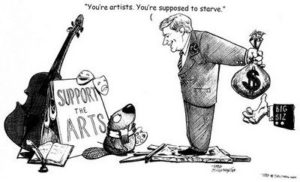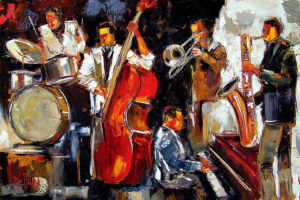
Art is both extremely appreciated in the world and under appreciated; while there seems to be a public interest in art and what art can do for people, there is an obvious lack of interest in the funding of those who create—fortunately, there exist ways of leaping over that boundary today.
There two particular reasons for the difficulty pursuing a career in art and succeeding: there are a lot of people trying to pursue this career path and there are only a limited amount of opportunities for financial stability as an artist—though with things like the internet, artists are certainly gaining more chances to pursue art and succeed financially. Beyond the help of the internet, there has been one position that has helped musicians and artist pursue their desires for a fairly long time known as teaching.

The life of most musicians and artists today consists of a constant grind and combination of making connections, gigging or performing, and teaching—typically, the most stable part of this combination is teaching. The option to teach is a gift which enables musicians to support themselves financially as they try and pursue the creation of music or visual art, as well as the continuation of the music tradition—of course, there also exist those who want to teach the future generations the tradition of art.
Fortunately, there has been a recent growth in other platforms and systems which have allowed for artist to sell and expose their art, by giving them full control of their art and its distribution—this includes the internet and several of its platforms. Platforms like YouTube, created by Chad Hurley, Steve Chen, and Jawed Karim and Patreon, founded by Jack Conte, are tools which fully enable musicians, artists, and creators to distribute their work and then make a stable living off of it.

The internet platform YouTube allows artists a potential broad audience for their work, helping them gain the exposure necessary to eventually make a living off their work through management of advertisements on their videos. While it is more common that musicians and other creators use this platform, there are many visual artists who also use the platform as a method to financially support themselves and gain exposure, including: Zach Hsieh, a self-taught comic book artist—this amount of opportunity is much different from the difficulty present in beginning of the twenty first century and the 20th century, when artist needed to rely on large corporations and production companies to manage them and their work. There even exist sites like Patreon, which once an artist establishes an audience, allows the artist to give addition art to their audience and receive compensations through a subscription like service.
Link to Zach Hsieh’s YouTube channel: https://www.youtube.com/channel/UClQubH2NeMmGLTLgNdLBwXg/featured

Steve Prince, an artist and educator from New Orleans, and the center for our INTD 288 course, is an excellent example of an artist who has put in a lot of time in the grind for the success of his art. He made the often-difficult decision of pursuing a career in art, and started the grinding process so that he might distribute his art, impact the lives, and bring further awareness to significant events that deserve recognition. Prince started teaching to support himself and his family, later fell in love with the idea of teaching his community and the future generations, and then succeeded to effectively distribute his art and reach people.
